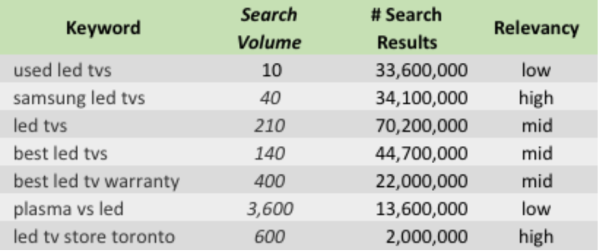Importance of Keywords in your Search Engine Optimization initiatives. Let's look at drawing them up.
Discovering your keywords - How to choose Keywords for SEO
1. Brainstorm your best bets
google autocomplete
Wikipedia
2. Ask others
clients
customers
random samples
target segments/buyer personas
3. Use keyword tools
Google Keyword Planner
Bing Keyword Research Tool
SEMRush (Paid)
Google Trends
4. Check site searches
5. Search social media
6. Examine competitors
7. Site Relevance
8. Search Activity
9. Conversion Potential
10. Competitiveness
11. Audience targeting
12. Return on Investment
Evaluating your keywords
Rule of thumb: A website can only target 1 keyword for each page. This means that the more content and pages you have, the more keywords you get to include to match yourself with target users.
Refine the list in Step 1 based on these factors which you can draw out in an excel grid:
1. Keywords
2. Search Volume
3. Competitiveness (in SERP)
100,000 = Easy
100K - 1M = Relatively Easy
1M - 10M = Moderately Competitive
10M - 100M = Competitive
>100M = Extremely Competitive
4. Competitiveness based on the number of Indexed Pages / Search Results. Take the total number of pages as displayed on the SERP

5. Assign Subject Level of Relevancy
Rank low - mid - high based on your understanding of the business based on relevancy to the keywords to your best assessment

6. Compare Domain Authority and Page Authority using Moz Toolbar
7. Relevancy
8. Stage of the Buying Circle (STOBC) - AIDA Model
Assign your AIDA STOBC

9. CalculateKeyword Efficiency Index (KEI)
KEI = Number of Pages Index in Google Results (A) / Number of Monthly Keyword Searches (B)

KEI is a good starting point to look at competition when you are trying to figure out how to choose keywords for SEO. But do not take this as a reliable indication of the quality of competition. KEI prioritizes keywords with a lot of demand (search volume) but little supply (indexed pages). The assumption made when KEI is calculated is that there must be some good opportunity to drive a large sum of traffic if there is a lot of volume with little competition. A keyword can come back with a high KEI even though it is irrelevant to your business, so ensure to follow the steps and include the Relevancy and Stage Buying Cycle Evaluation steps.
Choosing the right keywords is a critical step in effective SEO. Here's a guide on how to choose keywords for SEO:
Understand Your Audience: Start by knowing your target audience. Who are they, and what are they searching for? Consider their demographics, interests, and pain points.
Research Your Niche: Investigate your niche and industry. What topics, products, or services are relevant? Identify your competitors and their keyword strategies.
Make a Keyword List: Create a list of seed keywords that represent your business or content. These should be broad terms that encapsulate your focus.
Use Keyword Research Tools: Utilize keyword research tools like Google Keyword Planner, SEMrush, Ahrefs, or Ubersuggest to expand your list. These tools provide data on search volume, competition, and related keywords.
Long-Tail Keywords: Incorporate long-tail keywords, which are more specific and have less competition. These can attract users with a higher intent to convert.
Search Volume: Balance between keywords with high search volume and those with lower competition. High-volume keywords are competitive, while low-volume keywords may not drive much traffic.
Relevance: Prioritize keywords that are relevant to your content or business. Using irrelevant keywords can harm your SEO.
Intent: Consider user intent. Are people searching for information, products, or solutions? Match your keywords to the intent of your content.
Competitiveness: Assess the competition for each keyword. High competition may require more effort to rank, so consider a mix of competitive and less competitive keywords.
Localization: If your business has a local presence, use local keywords that include your city, region, or neighborhood.
Seasonality: Be aware of keywords that have seasonal trends. Plan your content and optimization accordingly.
Keyword Variations: Explore keyword variations, synonyms, and related terms. This ensures your content is comprehensive and captures different search queries.
User-Friendly: Choose keywords that read naturally and fit into your content seamlessly. Avoid keyword stuffing, which can harm your SEO.
Check Search Engine Results: Search your chosen keywords on search engines to see what kind of content ranks. This can give you an idea of the competition and the type of content needed to rank.
Track and Analyze: Implement your chosen keywords in your content and monitor their performance using analytics tools. Adjust your strategy based on the results.
Content Quality: Remember that keywords should enhance your content, not dominate it. Create high-quality, informative, and engaging content that satisfies user intent.
Stay Updated: SEO is dynamic, and search trends change. Regularly update your keyword strategy to adapt to shifting user behaviors and market changes.
Choosing the right keywords is a fundamental aspect of SEO success. It requires a combination of research, analysis, and an understanding of your audience's needs. An effective keyword strategy helps your content rank higher in search results, drive organic traffic, and connect with your target audience.
Other Useful tools that can help you with research data
